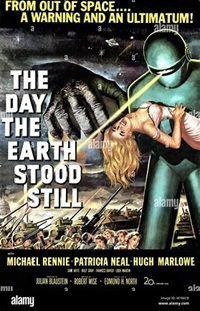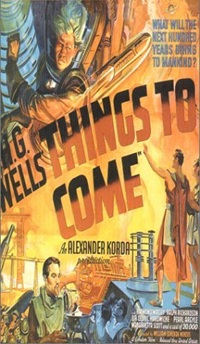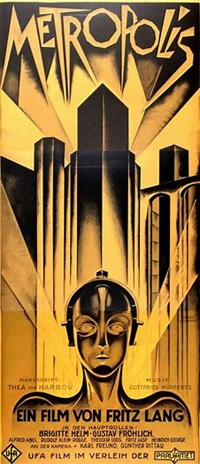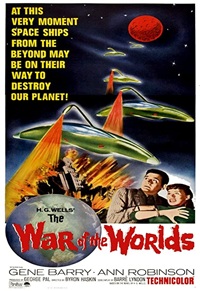
 |
|

"The Day the Earth Stood Still" (1951)
is a science fiction film directed by Robert Wise, an American filmmaker.
This iconic movie has become a cultural phenomenon and a staple of the genre.
The story takes place in 1951 (the film was released
during the height of the Cold War), where an alien spaceship lands on Earth,
carrying an extraterrestrial being named Klaatu (played by Michael Rennie)
and his robotic companion Gort. The aliens come to warn humanity about its
reckless behavior and threaten to destroy the planet if it doesn't change
its ways.
The movie explores themes of peace, understanding,
and cooperation, as Klaatu tries to make contact with Earth's leaders and
scientists. However, his message is met with skepticism and hostility, leading
to a series of tense confrontations that ultimately put humanity on the
brink of destruction.
"The Day the Earth Stood Still" is notable
for its thought-provoking themes, which resonated with audiences during
a time of global uncertainty.
|
The film's commentary on the dangers of war, nuclear
proliferation, and humanity's relationship with technology remains relevant
today.
The movie also features iconic imagery, such as
Gort's glowing eyes and Klaatu's eerie calm demeanor. The special effects
were groundbreaking at the time, showcasing miniature models and elaborate
sets that created a sense of realism.
"The Day the Earth Stood Still" has
had a lasting impact on popular culture, influencing countless sci-fi films,
TV shows, and books. It's a must-see for fans of classic science fiction
and anyone interested in exploring the human condition through the lens
of extraterrestrial life.
|
 |
|

"Things to Come" (1936) is a science
fiction film directed by William Cameron Menzies, an American filmmaker.
The movie is considered a precursor to the dystopian genre and has had a
significant influence on many subsequent sci-fi films.
The story takes place in a not-too-distant future,
where humanity has become complacent and lazy, leading to a catastrophic
decline of society. The film follows a group of people who survive an environmental
disaster and must adapt to a new world where technology and nature have
merged in unexpected ways.
The movie is notable for its themes of social
commentary, predicting issues like overpopulation, pollution, and the consequences
of unchecked technological progress. It's also known for its innovative
special effects, which were groundbreaking at the time, featuring elaborate
miniature sets and optical illusions to depict the futuristic world.
"Things to Come" has been praised for
its prescience in addressing concerns about the environment, technology,
and humanity's relationship with nature. If you're interested in classic
sci-fi or enjoy thought-provoking films, "Things to Come" is definitely
worth checking out!
|
 |
|

Flash Gordon Conquers the Universe" is a
1940 American science fiction film serial produced by Universal Pictures
and directed by Ford Beebe and Frederick Stephani. It is the third installment
in the Flash Gordon franchise, following "Flash Gordon" (1936)
and "Flash Gordon's Trip to Mars" (1938).
The serial follows the adventures of Flash Gordon,
a fearless athlete and explorer, as he travels to the planet Mongo with
his friends Dale Arden and Dr. Hans Zarkov to stop the evil Emperor Ming
the Merciless from conquering Earth. Along the way, they encounter various
alien species, including the Hawk Men, the Lion Men, and the Tree Men, each
with their own unique abilities and motivations.
The serial features a mix of science fiction elements,
action sequences, and melodrama, as Flash Gordon and his companions battle
to save the world from Ming's sinister plans. The story is full of twists
and turns, with plenty of cliffhangers to keep viewers on the edge of their
seats.
|
"Flash Gordon Conquers the Universe"
was a commercial success and helped cement the franchise's status as a beloved
classic in the science fiction genre. It has been released on DVD and is
still enjoyed by fans today for its nostalgic charm, colorful characters,
and thrilling adventures.
|
 |
|

"Metropolis" (1927) is a German science
fiction film directed by Fritz Lang, considered one of the most influential
and iconic films in the history of cinema.
The story takes place in a futuristic city known
as Metropolis, where the wealthy elite live in luxury above ground, while
the working class toils below ground in underground factories. The protagonist,
Freder (played by Gustav Fröhlich), is the son of the city' s ruler,
Joh Fredersen. One day, Freder becomes fascinated with the lives of the
workers and decides to venture into their world.
There, he meets Maria (played by Brigitte Helm),
a mysterious woman who seems to hold the key to uniting the workers against
their oppressors. As Freder becomes more embroiled in the workers' struggles,
he discovers that Joh Fredersen is planning to use advanced technology to
maintain control over the city and crush any dissent.
"Metropolis" is a groundbreaking film
that explores themes of class struggle, technological anxiety, and the dehumanizing
effects of industrialization. The movie features stunning sets, elaborate
costumes, and pioneering special effects, showcasing Lang' s innovative
use of lighting, camera angles, and composition.
|
The film's depiction of a futuristic world with
towering skyscrapers, massive machinery, and advanced technology was revolutionary
for its time. The movie also explores the consequences of unchecked technological
progress, foreshadowing many of the concerns about automation, artificial
intelligence, and environmental degradation that we face today.
"Metropolis" has had a profound influence
on science fiction, film noir, and architecture, inspiring countless works
of art and literature. It' s a must-see for anyone interested in the evolution
of cinema, as well as those fascinated by the intersection of technology,
society, and humanity.
|
 |

The "War of the Worlds" radio broadcast
refers to a famous radio play adaptation of H.G. Wells' classic science
fiction novel, broadcast on October 30, 1938, by Orson Welles and his Mercury
Theatre company.
The show was presented in a news bulletin style,
with actors playing reporters, government officials, and other characters
describing a Martian invasion of New Jersey and subsequent spread to the
rest of the world. The broadcast began with a disclaimer stating that it
was a work of fiction, but many listeners tuned in late and missed this
warning.
As the show unfolded, reports of panicked audiences
and widespread confusion flooded in. Many listeners believed that a real
Martian invasion was underway, and news outlets received calls from frantic
citizens asking about the crisis. The New York Times reported on the "panic"
caused by the broadcast, with people rushing to churches, hospitals, and
other safe zones.
|
|
|
The show's realistic portrayal of events, combined
with the limitations of radio technology at the time, created a sense of
immediacy that led many listeners to believe the events were real. The panic
was further fueled by newspapers and newsreels that reported on the "invasion,"
although they later clarified that it was a hoax.
The "War of the Worlds" broadcast remains
one of the most famous examples of mass hysteria caused by media, and its
impact on popular culture is still felt today. It has been cited as an example
of the power of radio to shape public opinion and create a sense of collective
anxiety.
Interestingly, H.G. Wells himself was reportedly
delighted with the adaptation, praising Welles' innovative approach to storytelling
and his ability to bring the classic novel to life in a new and exciting
way.
The "War of the Worlds" radio broadcast
has been re-broadcast several times since its original airing, often as
a nostalgic reminder of the power of radio and the enduring appeal of science
fiction. It continues to fascinate audiences, serving as a testament to
the enduring impact of Orson Welles' creative genius on popular culture.
|
|


